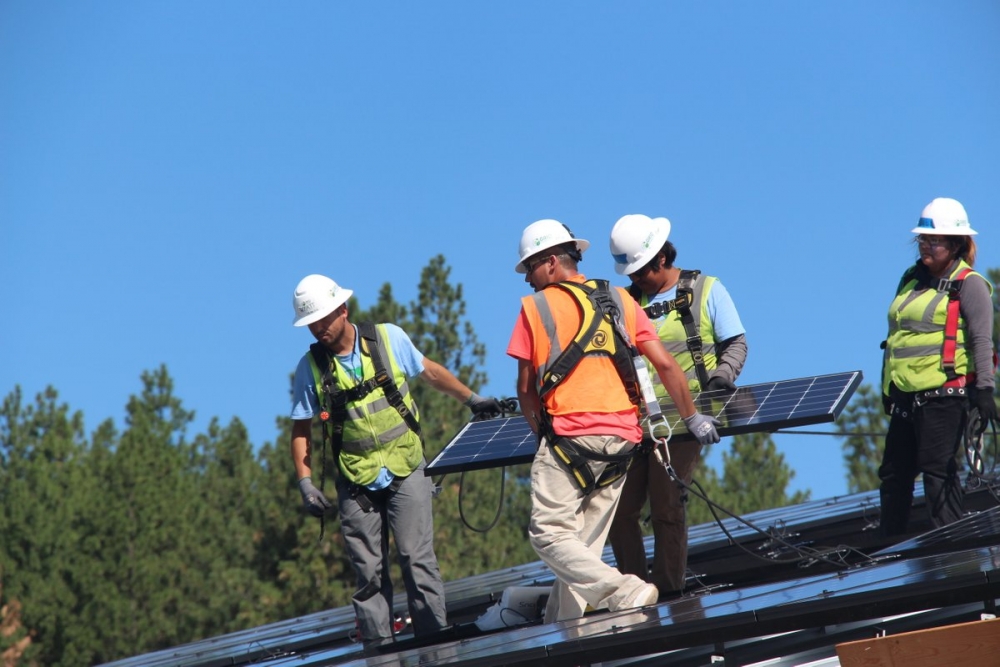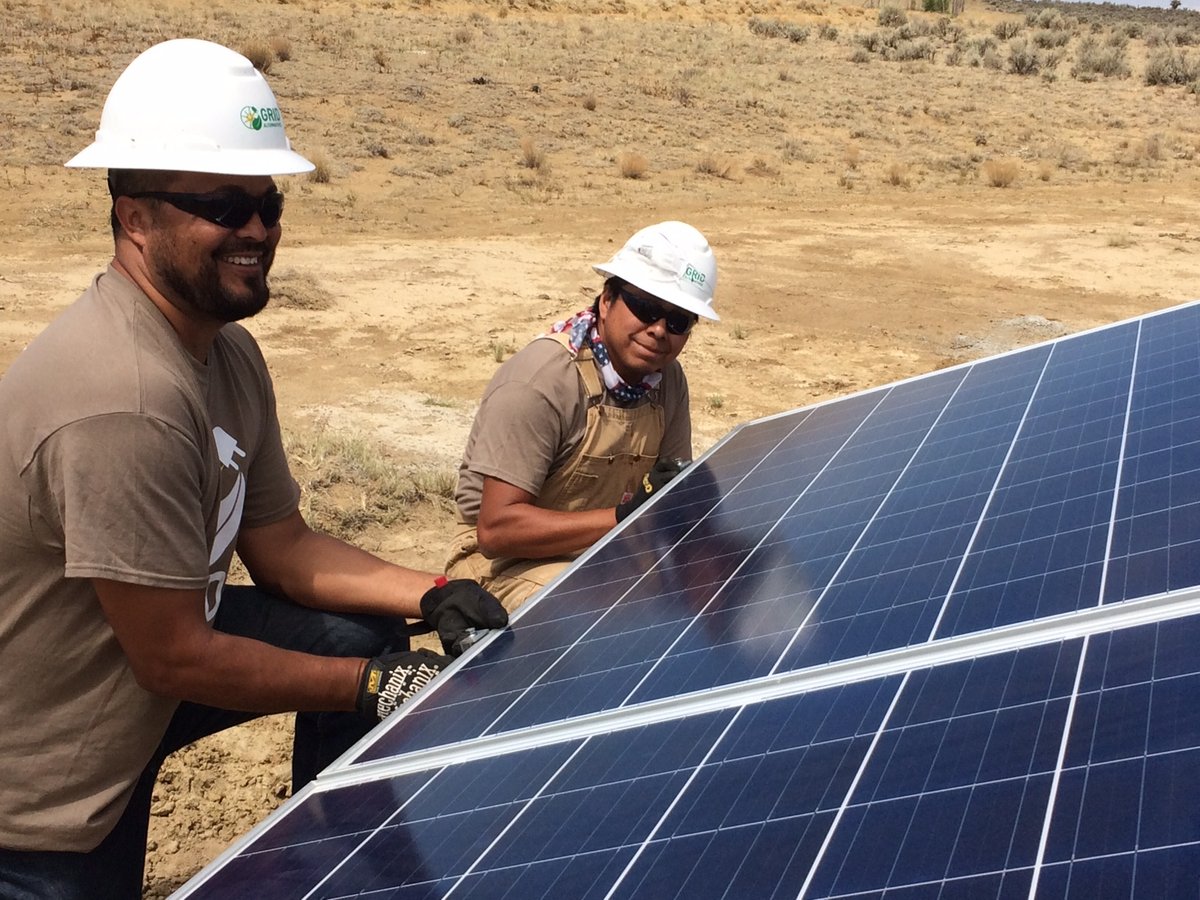
- Details
- By Joe Boomgaard
- Energy | Environment
The Tribal Solar Accelerator Fund, which aims to spur growth in solar energy and expand solar job opportunities in tribal communities across the country, has provided grants to 12 tribes for new clean energy projects.
Now in its third year, the Tribal Solar Accelerator Fund is an offshoot of GRID Alternatives, an Oakland, Calif.-based nonprofit working to make renewable energy technology and job training accessible to underserved communities.
Based on “overwhelming interest” in prior rounds, the fund’s 2020 cycle was open by invitation only and for the first time expanded geographically to back projects in Alaska. This year’s round included more than $1.5 million in grants to the 12 tribes.
Tribal Solar Accelerator Fund works with matching funds from the U.S. Department of Energy Indian Energy program to further renewable energy in Indian Country. Personnel from Tribal Solar Accelerator Fund will staff and manage the projects through 2021.
“The ability to develop and regulate renewable energy is an expression of sovereignty and self-determination,” Tanksi Clairmont (Lakota), director of Tribal Solar Accelerator Fund, said in a statement. “Our vision for Indian Country is a transition to energy sovereignty that is educational, entrepreneurial, and completely renewable.”
 Courtesy photo.
Courtesy photo.
Tribes selected in this year’s cycle were:
- Bear River Band of the Rohnerville Rancheria in Loleta, Calif. Bear River plans to install 37kW rooftop solar systems on homes owned by up to eight low-income members, with priority for the elderly and disabled. Up to six tribal members will receive on-the-job skills training and a week-long training session leading to a certification.
- Blackfeet Nation for the Heart Butte High School in Browning, Mont. GRID Alternatives will install the 160 kW Blackfeet Community Sustainable Energy Project at the high school and offer paid training for students and community members. The solar installation is estimated to offset about one-third of the facility’s energy usage.
- Cahuilla Band of Indians in Anza, Calif. The tribe will install roof-mounted or ground-mounted solar systems on the homes of eight elders. According to estimates, the systems should lead to a 35-percent to 75-percent reduction in electric bills for the homeowners.
- Campo Band of Mission Indians in Campo, Calif. Under the Green Energy project, six tribal members will have their homes outfitted with solar photovoltaic systems, leading to an expected annual savings of $1,500-$2,700 over the project lifetime.
- Coyote Valley Band of Pomo Indians in Redwood Valley, Calif. The tribe plans to add a 26kW rooftop solar system on the Coyote Valley Youth Education Center, which will generate an estimated $100,000 in energy savings.
- Manzanita Band of the Kumeyaay Nation in Boulevard, Calif. The 40kW solar project will start with systems installed on the Manzanita Activity Building and Manzanita Tribal Office and eventually set the groundwork for solar projects across the reservation.
- Oglala Sioux Tribe in Pine Ridge, S.D. The Oglala Omaste project will install solar systems on four low-rent units for veterans receiving HUD assistance and one low-rent unit under the Rural Innovation program. It also includes two large arrays on the Johnson Holy Rock Administration Building, which serves as the headquarters of Oglala Sioux Lakota Housing.
- Pinoleville Pomo Nation in Ukiah, Calif. The tribe plans to install a 19kW rooftop solar system on its new Head Start Youth Facility, which serves 60 children under the age of 5. The community plans to use the system as a model for member engagement and training.
- Sherwood Valley Band of Pomo Indians in Willits, Calif. The tribe will install 15kW in residential solar systems for six members and add 85kW of battery storage for low-income tribal members, who largely rely on generators and propane for energy. The project also will involve up to 300 hours of hands-on skills training.
- Tanana Chiefs Conference and Tanacross Village Council in Tanacross, Alaska. The project involves the installation of 74kW of rooftop and ground-mount solar systems tied into the grid, along with a 14 kW lithium battery bank for three buildings: the tribal clinic, community hall and multi-use facility; the Tanacross Biomass Facility; and Tanacross Water Plant. The system is expected to generate 84 percent of the annual energy demand, leading to a yearly savings of $17,000 for the tribe. The project also involves workforce development activities during the installation with the goal of hiring tribal members to operate and maintain the system.
- Torres Martinez Desert Cahuilla Indians in Thermal, Calif. The tribe plans to install 17.55 kW of solar on a trio of single-family low-income homes. Two tribal members also will work with GRID Alternatives and receive paid job training.
- Village of Solomon, Nome, Alaska. Under the project, the village plans to invest $87,000 to install a 7kW rooftop system on its community building. The project also aims to provide education and training for 20 “energy champions.”
GRID Alternatives launched the Tribal Solar Accelerator Fund in 2018, backed by a $5 million commitment from Wells Fargo over three years. The tribal-led initiative brings new funding to tribes for renewable energy generation, while also prioritizing training and education for members to work in the renewable energy industry.
“These projects will help improve resiliency and housing affordability in tribal communities, and provide hands-on training opportunities for tribal members interested in clean-economy jobs,” Ramsay Huntley, sustainable finance strategist at Wells Fargo, said in a statement, adding that the institution is committed to the Tribal Solar Accelerator Fund’s mission “to advance energy sovereignty in Indian Country.”
Kirsten Rumsey, content and media manager at GRID Alternatives, said Tribal Solar Accelerator Fund invited 22 tribes to apply for grants.
The applications were selected based on the match of the project and the funding priority, the focus on building renewable energy infrastructure, the experience to pull off a successful project, measurable goals, a feasible budget, the presence of partnerships that encourage tribal community participation and the potential for replication in other tribal communities, she said in an email to Tribal Business News.
--
EDITOR’S NOTE: This story has been updated with additional information about the funding round and criteria.
